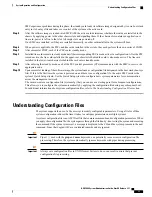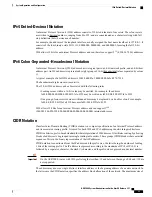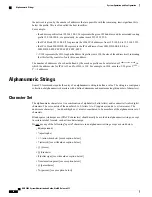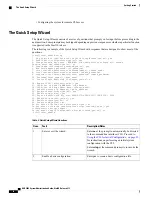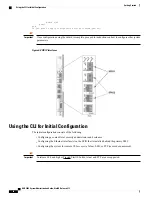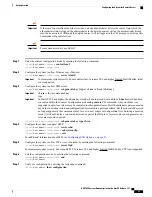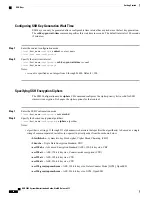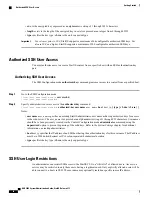
This section provides instructions for performing these tasks using the CLI.
Step 1
At the CLI prompt, enter:
[local]
host_name
#
configure
[local]
host_name
(config)#
Step 2
Enter the context configuration mode by entering the following command:
[local]
host_name
(config)#
context local
[local]
host_name
(config-ctx)#
The
local
context is the system's management context. Contexts allow you to logically group services or interfaces. A
single context can consist of multiple services and can be bound to multiple interfaces.
Step 3
Enter the following command to configure a context-level security administrator for the system:
administrator user_name [ encrypted ] password password | [ ecs ] [ expiry-date date_time ] [ ftp ] [
li-administration ] [ nocli ] [ noecs ] [ timeout-absolute timeout_absolute ] [ timeout-min-absolute
timeout_min_absolute ] [ timeout-idle timeout_idle ] [ timeout-min-idle timeout_min_idle ]
You must configure a context-level security administrator during the initial configuration. After you complete the initial
configuration process and end the CLI session, if you have not configured a security administrator, CLI access will be
locked. For complete information on the above command, see the
Context Configuration Mode Commands
chapter of
the
Command Line Interface Reference
.
For security reasons,
li-administration
accounts must be restricted for use only with Lawful Intercept (LI)
functionality and not for general system administration. Only security administrators and administrators can
provision LI privileges. To ensure security in accordance with Law Enforcement Agency (LEA) standards, LI
administrative users must access the system using the Secure Shell (SSH) protocol only. LI privileges can be
optionally configured for use within a single context system-wide. For additional information, see the
Lawful
Intercept Configuration Guide
.
Note
Step 4
Enter the following command at the prompt to exit the context configuration mode:
[local]
host_name
(config-ctx)#
exit
[local]
host_name
(config)#
Step 5
Enter the following command to configure a hostname by which the system will be recognized on the network:
[local]
host_name
(config)#
system hostname host_name
host_name
is the name by which the system will be recognized on the network. The hostname is an alphanumeric string
of 1 through 63 characters that is case sensitive.
Step 6
Configure the network interfaces on the SPIO using the following instructions:
a) Enter the context configuration mode by entering the following commands:
[local]
host_name
(config)#
context local
[local]
host_name
(config-ctx)#
b) Enter the following command to specify a name for the interface:
[local]
host_name
(config-ctx)#
interface interface_name
interface_name
is the name of the interface expressed as an alphanumeric string of 1 through 79 characters that is
case sensitive. The following prompt appears as the system enters the Ethernet Interface Configuration mode:
[local]
host_name
(config-if-eth)#
c) Configure an IP address for the interface configured in the previous step by entering the following command:
{ ip address | ipv6 address } ipaddress subnetmask
ASR 5000 System Administration Guide, StarOS Release 21.1
23
Getting Started
Using the CLI for Initial Configuration
Summary of Contents for ASR 5000
Page 26: ...ASR 5000 System Administration Guide StarOS Release 21 1 xxvi Contents ...
Page 316: ...ASR 5000 System Administration Guide StarOS Release 21 1 288 VLANs VLAN Related CLI Commands ...
Page 400: ...ASR 5000 System Administration Guide StarOS Release 21 1 372 Engineering Rules ECMP Groups ...



